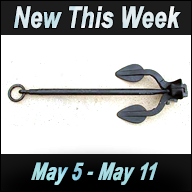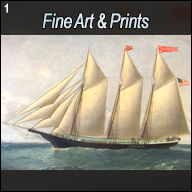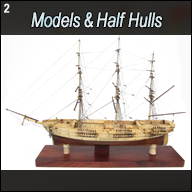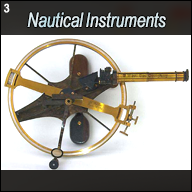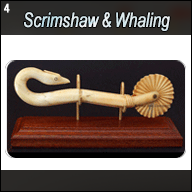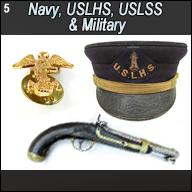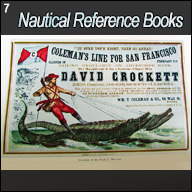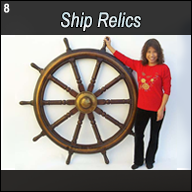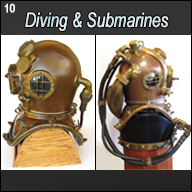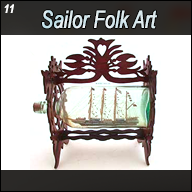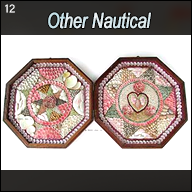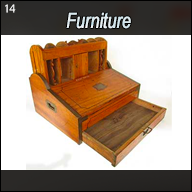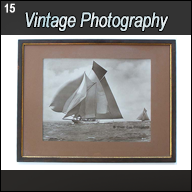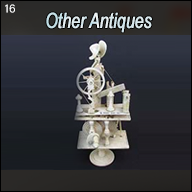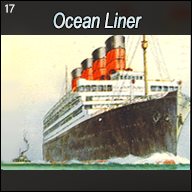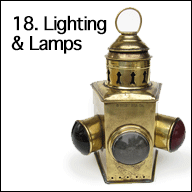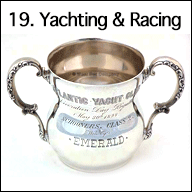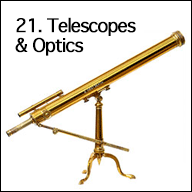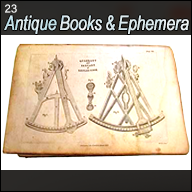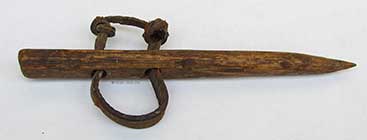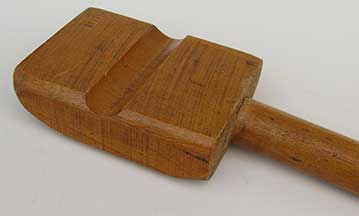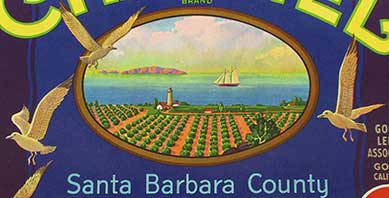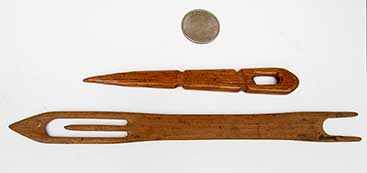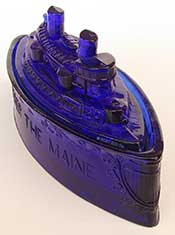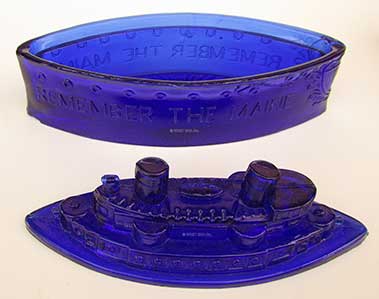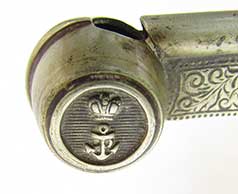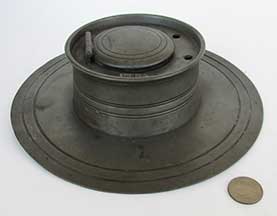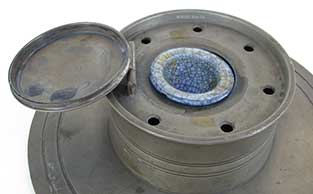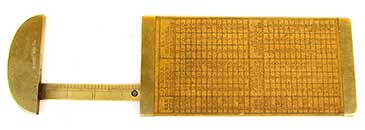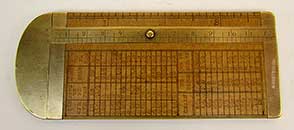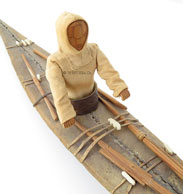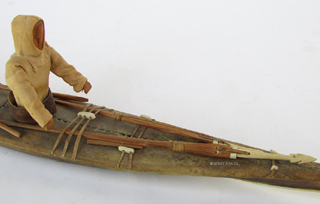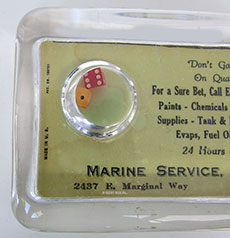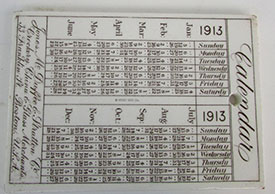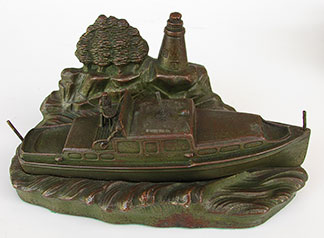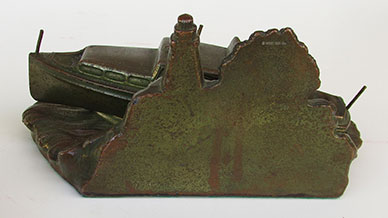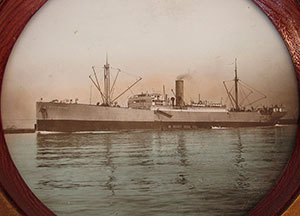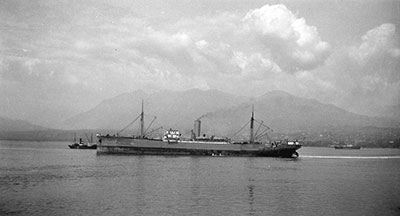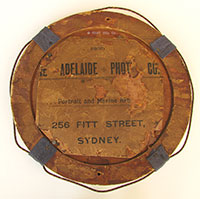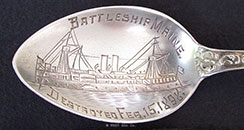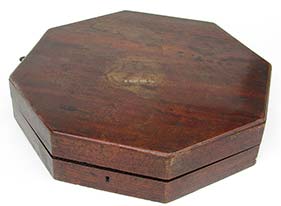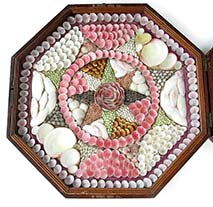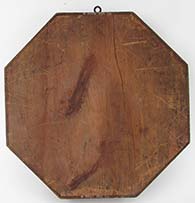12. Other Nautical
Prices in U.S. Dollars are in GREEN
 |
12.12 SAILOR’s VALENTINE. An authentic example of a form of sailor’s valentine embodied in a glass rolling pin painted with the endearment “Peace & Plenty,” enhanced with colorful flowers and leaves. This hand-blown tubular pin is made of lovely amethyst glass with its telltale deep purple tinge. In testament to its 19th century origin this pin has several bubbles in the glass and the open end knob has a jagged pontil commensurate with glassware of the era from antiquity. 13 inches long by 2 inches in diameter. While obviously delicate in nature, this lovely example is in perfectoriginal condition with no chips, cracks or damage. 295 Alan Major, author of “Maritime Antiques An Illustrated Dictionary,” 1981, Tantivy Press, London, goes to great lengths describing these sailor mementoes. He notes, “Early in the 19th century the more interesting blown-glass rolling pins began to be made in Bristol, Sunderland and Stourbridge. Such rolling pins were bought by seamen to take home as sailors’ valentines. Some of them were hollow and could be filled with various commodities. When a stopper and the contents were removed the rolling pin would be hung by a cord on the cottage wall, where the inscription on them would remind the wife or sweetheart of the absent donor. The seafaring community was always superstitious, and it was traditionally thought that if a glass rolling pin fell from the wall and was shattered, then the loved one would be lost in a shipwreck or to another woman. Collectors’ demand for these pins was so strong in the first part of our (20th) century that they were reproduced in considerable numbers.” |
 |
| reverse |
 |
12.11 SCHOONER DOOR STOP. Heavy solid bronze door stop in the form of a 2-masted schooner. It is beautifully molded with thick curved sails as the vessel plies a tempest tossed sea. The back bears the iconic mark “B & H” within a circle, the trademark of the prestigious Bradley & Hubbard Company. 6 ¼ inches high by 5 inches wide and 2 ½ inches deep. Outstanding condition in its original beautiful statuary bronze finish with bright golden highlights. 185 In 1852 the Bradley & Hubbard Company was formed in Meridian Connecticut producing artistic brass items including bells, candlestick holders, clocks, match safes, lamps, architectural grills, railings, etc. In its tenure the company patented 238 designs and mechanical devices. Richard Stamm of the Smithsonian Institution is quoted as stating, “By the 1890s, the Bradley and Hubbard name was synonymous with high quality and artistic merit." The Smithsonian has an extensive array of Bradley and Hubbard manufactured design objects in its collection. In 1895 a biography of co-founders Nathaniel Bradley and Henry Hall described Bradley & Hubbard as, "This company has enjoyed a phenomenal success. From a small concern, employing only six workmen, it has grown to occupy an immense plant of brick buildings, with a floor area of nearly seven acres, which employs 1,500 workers, with offices and sales rooms in New York, Boston, Chicago and Philadelphia." |
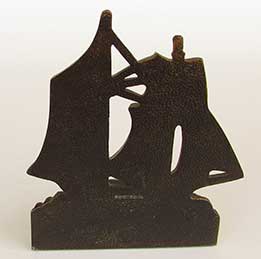 |
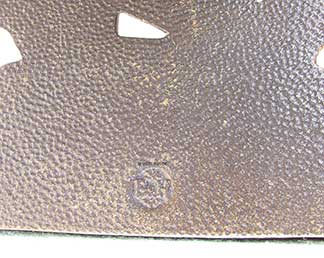 |
| back | mark |
 |
12.10 LIVERPOOL BOWL. Very early 1800’s nautical-themed bowl profusely decorated with transfers inside and out. Known as “Herculaneum” this fired paste ware bowl has 2 classic scenes on its interior. One is entitled the “SAILORS’ FAREWELL” reading “Sweet, oh Sweet is that Sensation, Where two hears in union meet: But the pain of separation, Mingles bitter with the Sweet.” The other is entitled the “MARINERS’ ARMS” depicting two sailors holding flags abreast an anchor with a full-rigged ship above. Three more ships are depicted on the horizon along with an anchor, cannon and shot. The outside shows two elegantly-dressed huntsmen flanking an elaborate coat of arms with the title “ANCIENT ORDER OF FORESTERS.” along with the All Seeing Eye. The reverse bears the poem reading “The sailor tossed on stormy seas, Though far his bark may roam, Still hears a voice in every breeze, That wakens thoughts of home; He thinks upon his distant friends, His wife, his humble cot And from his inmost heart ascends The prayer forget me not.” surrounded by floral motifs. The bowl measures 6 ½ inches in diameter and stands 3 ¼ inches high. Amazingly, after more than 200 years. it is still in PERFECT original condition! 795 |
 |
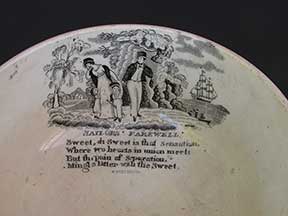 |
| bottom | image I |
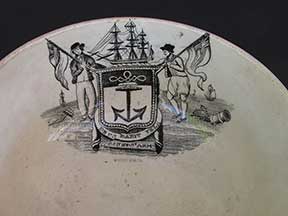 |
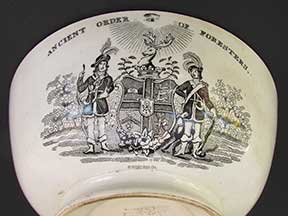 |
| image II | image III |
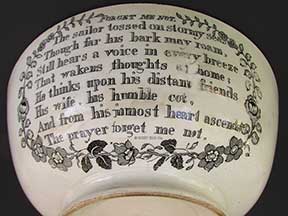 |
| image iV |
 |
5.40/12.09 LIGHTHOUSE SPOON. Antique sterling silver commemorative spoon depicting the famous Portland Head lighthouse in Maine. This example of the silversmith’s art is done in high relief with incredibly minute detail. The bowl features the famous sentinel poised on its rocky coastline with numerous buildings depicted. It is entitled “PORTLAND HEAD LIGHT.” The stem of the spoon is ornately cast with a crab, conch, flowers, a lobster, 2 codfish, and a sailboat next to a lighthouse contained within an oyster shell! The back is equally ornate, bearing the image of 2 crossed oars, a turtle, a block and tackle and a seagull in flight. It is clearly marked “STERLING” next to a larger “S” and a sea shell. 4 ¼ inches long. Condition is PERFECT! Such commemorative spoons commonly sell for less than $100. But this spectacular example is far from common! A bargain. 129 |
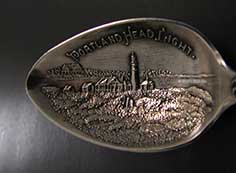 |
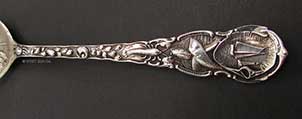 |
| bowl | stem |
 |
| sterling |
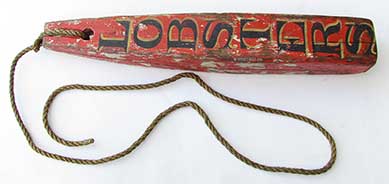 |
12.08 FOLK ART TRADE SIGN. Genuine hand-carved and painted 1800’s sign in the form of a lobster float. This charming one-of-a-kind advertising piece is not a typical lobster float from the period -- examples of which fetch hundred of dollars. This is an actual advertising sign offering lobsters for sale! Carved in the traditional shape, one side is beautifully painted in classic script with serifs and shadowing reading “LOBSTERS.” It is complete with its original old hemp rope seized on both ends in a seamanlike manner. The wooden body is 20 5/8 inches long and 3 inches square at the base, tapering at the top. The rope is over 4 feet long and can be adjusted to variable heights for display. Condition is original and excellent with expected age. The old red and black paint surfaces show decades of weathering just as collectors want them. The sign exhibits one large age crack on the left side., which is actually a good indication of its age and authenticity. Remarkably, the key advertising words “LOBSTERS” is in near perfect original condition. This is a scarce relic of the early New England fishery. Much rarer than a Nantucket basket or harpoon! Museum quality. 695 |
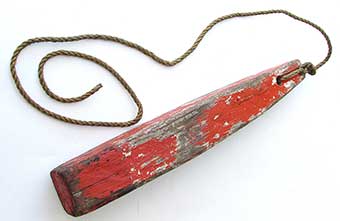 |
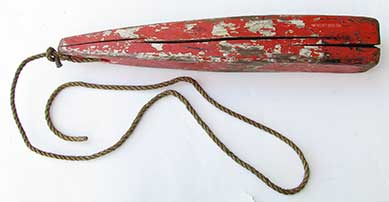 |
| perspective | back |
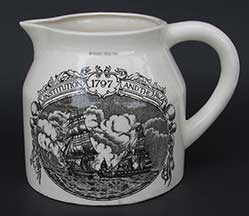 |
12.03 COMMEMORATIVE PITCHER. Early 1900’s Staffordshire creamware jug commemorating the famous Naval engagement between USS CONSTITUTION and the British frigate JAVA during the War of 1812. The double sided transfer depicts the furious sea battle in vivid detail. The scene is surrounded by a Naval motif proclaiming “CONSTITUTION (1797) AND THE JAVA.” The pitcher measures 7 inches wide inclusive of the spout and handle and stands 5 inches high. Perfect original condition. Rare. 179 The famous battle took place on December 29, 1812 off of the coast of Brazil. After 3 hours of intense fighting CONSTITUTION emerged victorious having damaged all 3 of JAVA’s masts and bowsprit while rendering many of her guns inoperable. After removing the British prisoners, Commodore Wm Bainbridge determined he could not tow JAVA to an American port. Accordingly, he directed a demolition party to light fires in JAVA’s hold causing her magazine to explode. Although CONSTITUTION sustained damage to her rigging and hull in the fight, she made it back to her home port of Boston on February 15, 1813. This was CONSTITUTION’s second victory in the war. En total, USS CONSTITUTION was undefeated in the War of 1812, having won her encounterss with HMS GUERRIER, JAVA, PICTOU, CYANE and LEVANT. It was in the battle with GUERRIER that CONSTITUTION earned the nickname “Old Ironsides.” When a British sailor noted a cannonball bouncing off CONSITUTION’s side he exclaimed "Huzzah! Her sides are made of iron!" |
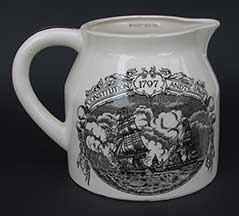 |
 |
| reverse | interior |
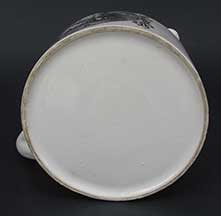 |
| bottom |
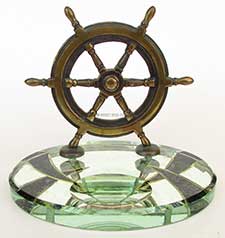 |
12.02 NAUTICAL DESK TOP. Striking desk top set featuring a realistic cast bronze ship’s wheel mounted atop a very thick beveled glass base. The base is incised on the bottom in an art deco motif highlighted in black and gold. The top front of the base has a polished cut glass depression which could serve as an astray, coin dish or for containing office smalls like paper clips, etc. The glass is an amazing ¾ inches thick with an elliptical footprint of 6 by 8 ¼ inches. The wheel is 6 3/4 inches in diameter from spoke to spoke and stands 7 inches tall overall. Excellent original condition noting some flaking of the mirrored glass on the bottom. The glass is perfect. 179 |
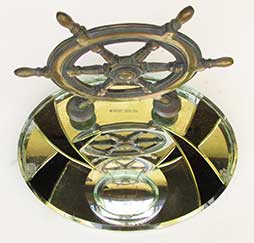 |
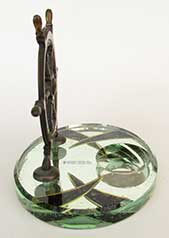 |
| top | side |
 |
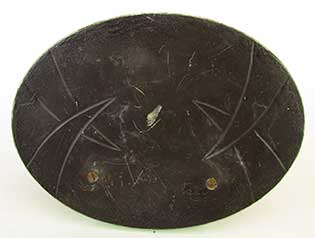 |
| back | bottom |
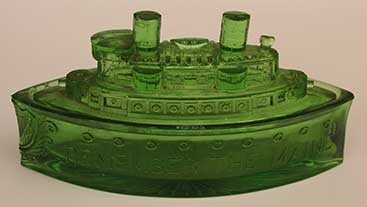 |
12.01 BATTLESHIP MAINE COMMEMORATIVE. Very scarce late 19th century memorial to the sinking of the famed Battleship MAINE in Havana Harbor, Cuba in early1898. The tragedy ultimately sparked the Spanish-American War. This rare lime green glass example is cast in the form of the famous battleship in remarkable detail. The lid forms the superstructure and the base is the repository. Both sides of the base are embossed "REMEMBER THE MAINE." The entire presentation is in pristine original condition after 120+ years. It measures 7 inches long by 3 inches wide and 3 ¾ inches high. 195 Subsequently, with resounding defeats in Cuba and the Philippines, Spain sued for peace. Hostilities were halted on August 12, 1898, when a Protocol of Peace between the United States and Spain was signed in Washington. The formal peace treaty was signed in Paris on December 10, 1898. As a result of the war the United States gained all of Spain's colonies outside of Africa, including the Philippines, Guam and Puerto Rico, excepting Cuba which became a U.S. protectorate. These gains prompted John Hay, America's Ambassador in Britain, to refer to it in a letter to his friend Theodore Roosevelt as "the splendid little war." Theodore Roosevelt and George Dewey benefited greatly from their participation in the war. Both men gained immediate fame as national heroes. Roosevelt's fame ultimately propelled him to the White House. Years later it was determined the Battleship MAINE did not explode and sink due to hostile action, but as a result of its faulty boilers. |
 |
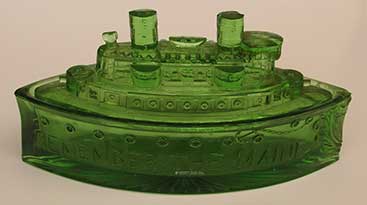 |
| bottom | starboard |
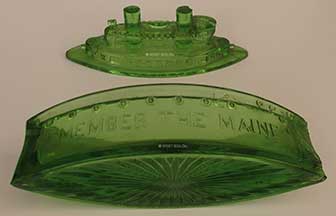 |
| components |
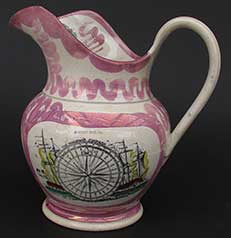 |
12.99 SUNDERLAND JUG. Scarce, very highly sought after early 1800's English pitcher with classic nautical scenes. Known as Sunderland pink lusterware, this rich decorative nautical ceramic bears a total of 4 nautical transfer scenes on its exterior and in its spout. On its right side is the poem reading, "The Sailor's Tear. He leap'd into the boat, As it lay upon the strand; But oh! His heart was far away, With friends upon the land, He thought of those he lov'd the best, A wife and infant dear: And feeling fill'd the sailor's heart The sailor's eye a tear." Under the spout is the vignette, "SAILOR'S FAREWELL. Sweet oh sweet is that separation. Where two hearts in unison meet. But the pain of Separation. Mingles little with the sweet." On the left side is the depiction entitled "THE MARINER'S COMPASS. "Then in the spout is the poem reading "Glide on my bark the summer's tide, Is gently flowing by thy side; Around thy prw the waters bright, In circling rounds of broken night, Are glitt'rings if ocean gives, Her countfless (sic) gems to deck the waves." This early pitcher is profusely decorated with hand-colored applications and colorful decorations surrounding the poems. Importantly, it is in absolutely perfect original condition after more than 185 years! It is extremely rare to find objects of this quality with such profuse imagery in this original condition! 9 inches tall by 9 ¼ inches wide at the handle. This is literally a museum piece! Present value $1500. 945 Literature: "Glide on my bark the summer's tide Is gently flowing by thy side Around thy prow the water's bright In circling round of broken light. Are glitt'ring as if ocean gave Her countless gems to deck the wave." |
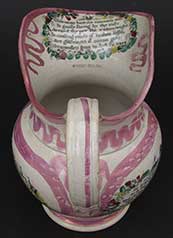 |
 |
| spout | sailors tear |
 |
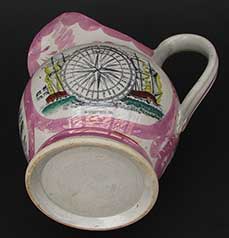 |
| sailors farewell | bottom |
 |
12.98 ESKIMO DOLL. Amazing late 19th century Eskimo effigy of a man clad in walrus fur chaps. This charming effigy is carved of whalebone with facial expression and implied arms. The unique dress is walrus hide above leather anklets with shoes tied off in sealskin sinew. The moccasins are especially well made, exhibiting detailed hand stitchery. The man stands 5 ¾ inches tall by 1 ¾ inches wide. There may be a few minor losses to the fur on the back side. Overall, very presentable and quite rare. A fine addition to any important collection of such objects from the far North. 795 |
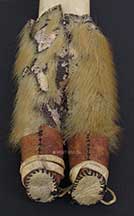 |
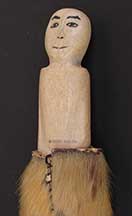 |
detail |
torso |
 |
back |
 |
12.97 NET SHUTTLES. A set of two genuine 19th century sailor-carved net shuttles used in making and repairing fishing nets. As is typical of American-made examples these are both carved of hard oak and retain portions of their original cotton line. The larger of the two has acquired a rich deep age patina, while the smaller bears fine line equivalent to sewing thread! The largest is 8 inches long by ¾ inches wide at the widest and 1/8 inch think. The other is 6 ½ inches long by ½ inches thick and is 1/8 inch thick. Both are in excellent original condition. 69/pr |
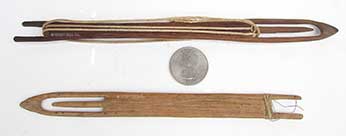 |
reverse |
 |
12.95 LARGE NET SHUTTLE. Authentic late 19th century net making tool. This unusually large example is bound with several fathoms of heavy cotton line. The shuttle is meticulously hand-carved of oak. Due to being wound with the cordage only the tip and the tail are visible along with both sides of the tool. Owing to the heft of the line and the size of the shuttle, it is safe to assume it was used in the salt water fishery. Amazing original condition. This is a humble working relic, beautifully preserved, from a time gone by. Certainly a museum piece in the fishing-related industry. 95 |
 |
REVERSE |
 |
SIDE |
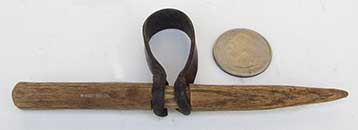 |
12.96 SAIL MAKER's AWL. Unique 19th century sailor's tool for mending canvas sails aboard ship. This hand-carved tool is made of hard white oak. Cleverly, the seaman maker carved a notch midway along its length to attach a leather thong to hold the index finger to provide additional force. The thong is a single piece of "U" shaped leather with eyes secured around the shaft on each end. It is an ingenious arrangement which obviously saw actual use, judging by the nice age patina to the wood and leather. The awl is 4 ¾ inches long and the leather loop is just shy of 2 inches. A very nice genuine example of the sail maker's craft from the true age of sail! 69 |
 |
REVERSE |
 |
12.94 CARVED HARDWOOD AWL. Working sailor's sail making fid beautifully turned and finished from an unidentified dense wood. Attached to the upper shaft is a leather loop to accommodate the worker's finger for a sure grip. 4 ½ inches long and 5/8 inches wide at the bulbous top. Outstanding state of original preservation. A very nice looking nautical "small." 119 |
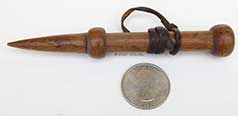 |
reverse |
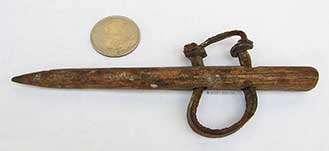
|
12.92 SAILOR's TOOL. Authentic 19th century hand-carved wooden sailor's miniature fid for mending sails, lines and nets. This early working tool is made of hard oak rove through with a leather thong to aid punching and piercing sails, line and fish. To those ends there are noticeable iridescent fish scales embedded in this early example. 5 ½ inches long. Original working condition. A real untouched relic from a classic age gone by at a remarkably low price. What does lunch cost these daze? 39 |
reverse |
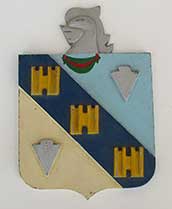
|
12.87 SHIP's PLAQUE. Cast aluminum ship's plaque bearing the crest of a post-war British warship, depicting a plumed knight in armor, castle gates and war arrows. Nicely hand-painted. With a little research this ship's name can be determined. 5 by 7 ½ inches. 15 |
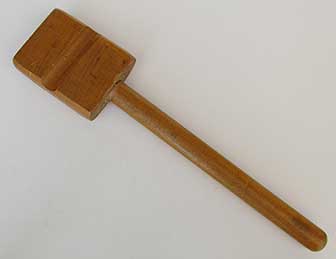
|
12.88 SERVING MALLET. Large sailor's working tool in the form of a device helping to "serve" (tightly wrap) small stuff around a larger line to prevent it from fraying. This commercially made example is constructed of hard, dense maple. 14 ½ inches long by 3 inches wide on the head. Very sturdy! 29 |
DETAIL |
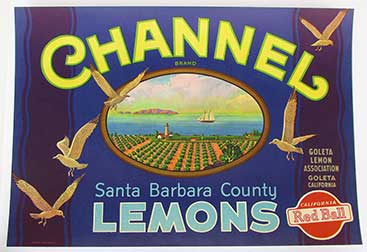
|
12.89 PACKING LABEL. Brilliant old California fruit crate label reading "CHANNEL Brand Santa Barbara County LEMONS, Goleta Lemon Association Goleta California (California Red Ball)." This artistic chromolithograph has a central oval scene depicting a schooner passing a lighthouse and lemon grove with Santa Cruz and Santa Rosa Islands on the horizon. Seagulls frolic in the surrounds. The image is bold and bright with intense colors. 9 by 12 ½ inches. MINT original condition dating from the 1940's. 39 |
detail |
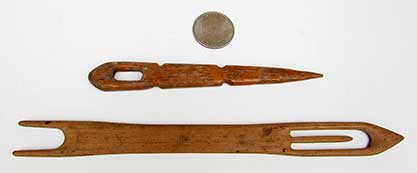
|
12.90 NET SHUTTLES. Pair of matching net making tools, consisting of a shuttle and an awl (driver). These genuine 19th century sailor's tools are finely hand-carved of dense oak made to exacting tolerances. The shuttle in particular is especially well made and bears close scrutiny to appreciate its workmanship. 7 ¾ and 5 inches long respectively. The awl is slightly thicker than 1/8 inch and the shuttle is amazingly just over 1/16 inch thick! Both in excellent original condition showing actual use by no abuse. 49/pr |
REVERSE |
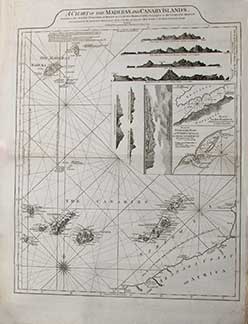
|
12.85 ANCIENT SEA CHART. Authentic ship's navigational chart published by "Laurie & Whittel No 53 Fleet Street, London in May 1794" as marked at the top under the title "A CHART Of The MADERAS And CANNARY ISLANDS Made by Order of the French Government in 1769." This handsome, very exacting map is engraved (with telltale plate marks) on heavy rag paper which was extremely valuable at the time. It is testament to the fact that the quality and accuracy of such charts held the fate of mariners in its hands. It depicts the said islands on the Northwestern coast of Africa in the mid-Atlantic ocean. It is done in topical relief showing the hills, rivers and geographic features of each of the islands. It also shows 7 coastal promontories as would be viewed by an approaching mariner to distinguish and identify shoreline features. In addition, two insets depict potential mooring locations with indicated depths for anchoring. This chart, measuring 22 by 28 inches in a remarkable state of original preservation considering it is over 2 and a quarter centuries old! No tears, stains or any other damage. A rare relic surviving from the early days of sale. 295 |
title |
inset |

|
12.86 WATERTIGHT CANNISTER. Early 1900's commercially-made container for a variety of shipboard uses. This solid copper canister has a press fit cover which slides into position against a raised boss on the side of the cylinder, providing a very secure tight seal. 10 inches tall inclusive of cover and 4 ¾ inches in diameter. Excellent original condition. 99 |
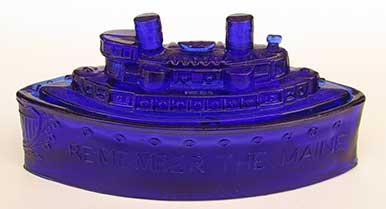
|
12.84 BATTLESHIP MAINE COMMEMORATIVE. Very scarce late 19th century memorial to the sinking of the famed Battleship MAINE in Havana Harbor, Cuba in early1898 which sparked the Spanish-American War. This rare cobalt blue glass piece is cast in the form of the famous battleship in remarkable detail. The lid forms the superstructure and the base is the repository. Both sides of the base are embossed "REMEMBER THE MAINE." The entire presentation is in remarkably pristine original condition after 120+ years. It measures 7 inches long by 3 inches wide and 3 ¾ inches high. 195 |
perspective |
components |
bottom |

|
12.82 CREW WATCH DRAW MARKERS. Rare! Complete, mint set of 12 numbered brass ship's crew draw markers made by noted nautical makers "John E. Hand & Sons, Philadelphia" as embossed in gold on the blue leather snap case. This World War II vintage set consists of 12 sequentially numbered brass bars 1 ½ inches long by 3/8 inches wide. At the start of all maritime voyages, the crew's watch rotation had to be determined. A conflict-free way to accomplish this task was for the Chief Officer to lay 12 markers face down on the chart table, shuffle them like dominoes and let each crewman pull a marker. This method of establishing the watch rotation was quick and without dispute. New old stock. A very obscure, little known historical marine relic! 149 |
detail |
cover |
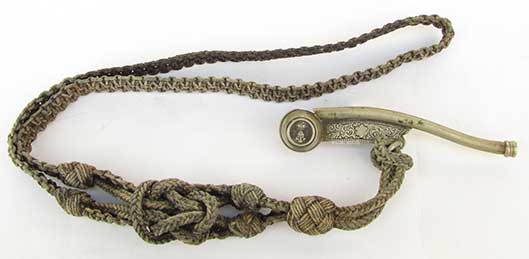
|
12.81 EARLY BOATSWAIN's CALL. Genuine 19th century boatswain's whistle of classic form complete with original sailor-macraméd lanyard. Known as a "pipe" or a "call" this nickel-silver whistle has a barrel cast in high relief with an anchor surmounted by a crown on both sides. The keel is highly embellished with floral designs and holds a ring for attachment to its lanyard. The dyed cotton lanyard is of has a very high quality with numerous complex sailor macraméd knots including a monkey's fist and 4 Turk's heads. The whistle is exactly 4 inches long and is 7/8 inches wide on the barrel. The lanyard measures 17 inches long. Outstanding original condition in all respects. This call emits a loud, shrill tone when blown. |
detail |
crown anchor |
lanyard |
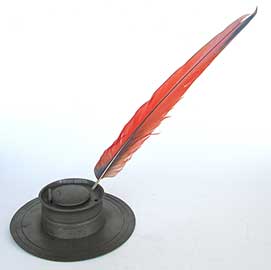
|
12.76 CAPTAIN's INKWELL. Extremely scarce, genuine early 19th century ship captain's inkwell made of pewter with a hard fired porcelain insert. Telling of its shipboard use, this writing implement has a very broad base measuring 9 inches in diameter. This of course was to keep the precious ink from tipping over in a seaway aboard a rolling sailing ship. The body of the well, measuring 4 ¾ inches wide, has 6 apertures for holding pen quills which surround the central porcelain well in the center. A hinged folding lid covers the well but not the apertures. The lid and the base are both scribed with double decorative concentric lines. Complete with a later colorful quill pen. We cannot overstate how rare this offering is! It will make a treasured statement on the desk of that self-described sea captain in the family. Guaranteed to be absolutely authentic and over 170 years old. Found on the sea coast of New Hampshire. Museum quality. 695 |
perspective |
top |
bottom |
ink well |

|
12.72 IVORY MARLINSPIKE/AWL. Professionally-made punch/bodkin/marlinspike/awl with a steel working end, a silver collar and a lovely octagonally faceted ivory handle. This working tool is signed "J.S. CHEVALIER" as stamped into the steel. One can assume this instrument was made in 19th century France. The contours of the instrument are continuous facets terminating in a very sharp point. Overall length 5 ¼ inches. Minor age checks in the ivory handle, otherwise perfect original condition showing good age. 195 |
handle |
maker |

|
12.70 MATE's ROPE GAUGE. Very scarce and highly prized late 1800's or very early 1900's hand-held device used by the ship's cargo officer to determine the size and breaking strengths of line and cable used aboard his ship. It is signed on the edge "JOHN RABONE & SONS BIRMINGHAM." This precision instrument is made of boxwood and brass, incised with a multitude of information about every conceivable type of connective lines, rope and wire in general sea cargo service. They include "SHROUD TAR'D HEMP COILS, LAID MANILLA COILS, HAWSER TARED HEMP COILS9 of MB, CHAIN WT PER FAM (Fathom), EQL TO HEMP ROPE and WIRE." On the reverse are indications for various weights and lengths of the material. They read, "WIRE CIRCUMFERENCE, ROPE Wt PER FAM (Fathom), HEMP SIZE, and ROPE Wt PER FAM ((Fathom). This device is essentially a caliper which indicates diameter and circumferences of the objects measured and then provides a readout of safe working loads in tons. A very accurate scientific instrument with a nautical purpose. 4 5/8 inches long by 1 7/8 inches wide and 1/8 inch thick. It expands to provide a measurable reading of 8 inches. Outstanding original condition in all respects. The best! 269 |
open |
reverse |
maker |

|
12.05 ESKIMO KAYAK. Very fine early 1900’s model of an Eskimo kayak, faithfully made in the traditional manner with seal skin over a wood frame connected by sinew and embellished with walrus tusk ivory components. This detailed model features a single Eskimo hunter carved of wood, clad in coarsely-woven, hand-stitched cloth. His handsome kayak is replete with two long walrus ivory-tipped harpoons and two wooden grappling tools. There are numerous other small ivory fasteners on the top of the craft connected with sinew. The bow and stern are further reinforced with ivory caps and runners attached with small wooden pins! This near scale, realistic presentation measures 20 ½ inches long by 2 3/8 inches wide. With the Eskimo caricature it stands 3 ¾ inches high. Outstanding original condition, beautifully preserved. 795 |
figure |
detail |
above |
bottom |
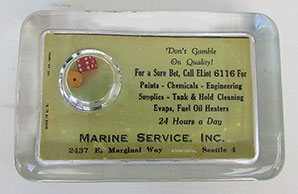
|
12.63 PAPER WEIGHT. Early 1900’s glass advertising paperweight with a very clever humorous marine and gambling association. It reads, “Don’t Gamble on Quality! For Sure Bet, Call Eliot 6116 for Paints – Chemical – Engineering Supplies – Tank & Hold Cleaning Evaps, Fuel Oil heater 24 Hours a Day MARINE SERVICE, INC. Seattle.” Charmingly it contains 2 free moving die which roll as the paperweight is moved. The thick clear glass measures 4 ½ by 2 ¼ inches and is 1 inches thick. A old reflective mirror is on the bottom. Outstanding original condition with no flaws, chips or scratches. One of the most amusing such marine-relating items we have ever come across. A great rarity for sure! 179 |
detail |
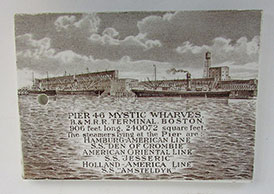
|
12.62 CALENDAR TILE. Highly collectible very early 1900’s porcelain advertising tile from 1913. This lovely glazed tile indicates the dates of 1913 as offered by the “Jones, McDuffre & Straton Co.” of Boston. Of great significance is the reverse which depicts a beautifully detailed view of the “Pier 46 Mystic Wharfs” showing the R. & M. R.R. Terminal Boston with the ships “HAMBURG AMERICAN LINE S.S. DEN OF CROMBIE, AMERICAN ORIENTAL, LINE S.S. JESSERIC, and HOLLAND AMERICA LINE S.S. AMSTELDYR.” 3 ¼ by 4 ¼ inches. Absolutely perfect original condition. Over 100 years old! 99 |
calendar |
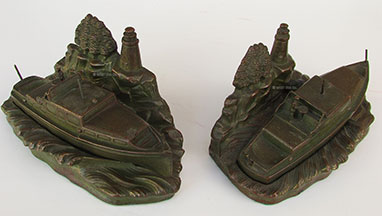
|
12.56 MOTOR LAUNCH BOOKENDS. Absolutely charming matched pair of heavy bronze bookends beautifully cast in the form of a power boat plowing through wavy seas. The cabin cruiser with open cockpit is depicted with the uniformed helmsman at the early-style vertical wheel. The sleek craft creates a rolling wake with the bow rising above the waves as it races past a forest and lighthouse on the cliff above. The casting details of every aspect of these quality bookends are exceptional -- statuary quality. 7 inches long by 4 inches wide and 3 ½ inches tall. Each bookend weighs 3 pounds. Circa 1930. This pair will make a significant statement in a power boat enthusiast’s library! 695 /pr |
perspective |
detail |
boat |
back |

|
12.67 EARLY SHIP COMMEMORATIVE. Genuine, early 1900's framed photograph of the famous American steamer identified as the S.S. STEEL WORKER. which met a disasterous end in the service of the U.S. in World War II. This handsome presentation consists of a period black and white photograph of the vessel that has been hand tinted. It is mounted under glass within a turned redwood frame in the form of a ship's wheel. The frame is decoratively hand-painted in a distinctive style, "S.S. STEEL WORKER" with a fouled anchor. The image measures 5 1/2 inches in diameter with the entire presentation being 12 inches across. Excellent original condition. 189 STEEL WORKER acquired an early reputation as a "hell ship" due to the conditions and lack of staples provided to the crew. In fact two entire crews deserted her in between runs from new York to the Panama Canal. But she went on to have an illustrious career as a commercial cargo carrier. As the World War II broke out she came under the control of the U.S.Maritime Commission. Carrying foodstuffs for the beleagured Russians under assaulut by the Nazi invasion, STEEL WORKER was sunk by a German mine just 3,000 years from her destination of the port of Mishayamp, Murmansk on June 3, 1942. |
DeTAIl |
SHIP |
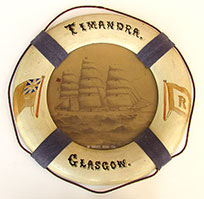
|
12.49 VERY EARLY LIFERING COMMEMORATIVE. Late 19th century ship memento commemorating the full-rigged sailing ship “TIMANDRA (of) GLASGOW” as beautifully painted at the top and bottom of the presentation. It consists of an original old albumen photograph of a painting of the lovely ship underway at sea with full sail. The house flag and the British ensign have been hand-touched in red. The nicely executed painting shows great detail including the ship’s call flags flown below the “old duster,” her trailboard and billethead on the bow and her nameboard abaft the anchor on the foc’sl. The image, measuring 6 inches in diameter, is protected under its original wavy glass. It is encircled by a carved wooden frame in the form of an old fashioned lifering. The British ensign is painted on the left and TIMANDRA’s house flag “R” is painted on the right. The periphery of the ring is fitted with a grab rope held by 4 sections of blue denim. Quite interestingly the reverse bears the framer’s advertisement, “From THE ADELAIDE PHOTO CO. … Portrait and marine Art. 256 Pitt Street, Sydney.” Obviously indicating this ship’s souvenir was made in Australia. The lifering itself measures 9 ¾ inches across. Excellent original condition showing good age on the front. The backing is toned with some losses, but is in tact. Overall it displays very well. It is a rare, early relic of its genre. Guaranteed to be over 120 years old! |
back |
ship |

|
12.41 COMMEMORATIVE SPOON. Genuine turn-of-the-last century sterling silver spoon representing “CATALINA ISLD.” as hand-engraved in the bowl. Under the inscription is also a hand-engraved scene of Avalon Harbor with a large yacht, sailboats and the pier in the bay. Surrounding the shoreline is the town of Avalon, hills and the historic Wrigley House on the right of the scene. The stem of the spoon is ornately decorated with floral designs, as is the back. At the junction of the bowl and stem is embossed “STERLING” and “PAT. 1901.” Further, there are 3 fine raised maker’s hallmarks including an anchor. The spoon measures 5 3/8 inches long overall and the bowl is 1 1/8 inches wide. Flawless, absolutely perfect original condition. All surfaces are bright, clean and as crisp as the day they were made over 110 years ago! 149 |
bowl |
marks |

|
12.40 BATTLESHIP MAINE COMMEMORATIVE. Late 19th century sterling silver spoon with the bowl hand-engraved with a beautiful image of the famous “BATTLESHIP MAINE, Destroyed Feb. 15, 1898.” The stem of the spoon is decorated with floral bouquets and is signed with lion hallmarks flanking a “W” marked “STERLING.” 5 inches long. Perfect original condition. 195 |
sterling |
bowl |

|
12.19 P.O.W. SNUFF BOX. Absolutely charming late 18th or very early 19th century carved bone folk art snuff box depicting a handsome gentleman suitor courting a lovely maiden. This intricately constructed box is indicative of the incredible output of French prisoners in British prisons during the Napoleonic War era. It consists of an inner core of solid wood that has been hollowed out. Overlaying the wood is sheathing consisting of bovine bone attached with tiny brass pins. The box opens with fine hand-made brass hinges and is equipped with a tiny friction latch which allows it to close with a positive fit, assuring preservation of its precious contents. The front of the box is engraved with the initials "CT DW." It is both relief carved AND engraved with floral motifs and a "brick" pattern. It measures 3 1/2 inches long by 2 1/4 inches wide and 1 1/4 inches thick. This snuff box is in an incredible state of original preservation with no damage or repairs whatsoever. A superbly rare example of 200 year old P.O.W. work with a delightfully endearing subject! 1895 |
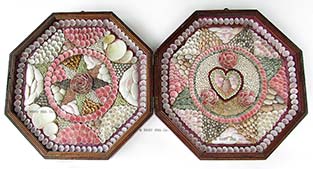
|
12.37 SAILOR’s VALENTINE. Early, very impressive, large double sailor’s shellwork valentine of the type produced in the Caribbean from the mid-1800’s onward. This example dates to the earliest production of these sailors’ mementoes as evidenced by the fact that it has a key lock -- a feature found only on the oldest, higher quality surviving examples. It is of classic diptych construction having two octagons hinged in the center. The cases are made of Spanish cedar having glazed covers of original old wavy glass protecting the fragile shells within. The geometric patterns so-formed are remarkably complex and extremely colorful. The left panel (also known as a “flat”) has a 6-side star with a central rosette. In keeping with the fact that this sailor memento was a souvenir for a loved one, the central theme of the right flat is a large heart encircled by 3 rosettes. Each flat measures 13 ¾ inches across with a combined overall width of 27 3/8 inches. Condition is absolutely outstanding, untouched, original. As bright and vibrant as it was made over 150 years ago! Museum-quality. |
perspective |
lid |
left |
right |
back |

